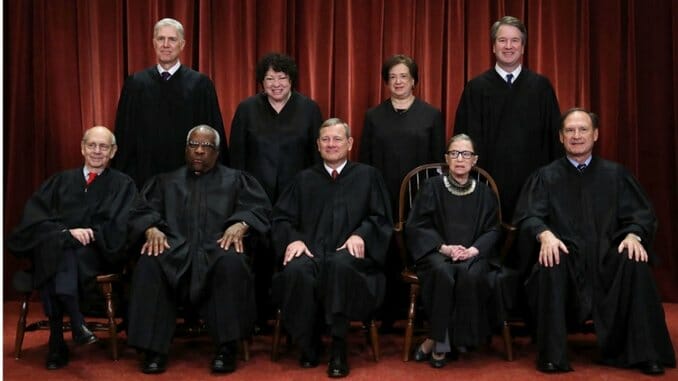The Ralph Nader Supreme Court
The Curmudgeon on Politics
Photo by Chip Somodevilla/Getty
The U.S. Supreme Court was a progressive force for the second half of the 20th century, but so far in this century, it’s been a reactionary force. It has enabled religious favoritism (2014’s Burwell v. Hobby Lobby,) voter suppression (2013’s Shelby County v. Holder), corporate corruption of elections (2010’s Citizens United v. Federal Election Commission) and easy gun possession (2008’s District of Columbia v. Heller).
This court could be called the Bush Court, for George W. appointed John Roberts and Samuel Alito. It could be called the Trump Court, for Donald appointed Neil Gorsuch and Brett Kavanaugh. But it could also be called the Nader Court, for Ralph did as much as anyone to insure the rightward tilt of the Supremes.
The present court is not an accidental byproduct of Nader’s presidential campaigns; it was an entirely predictable result of decisions Nader consciously made. And it’s a warning to anyone who believes that voting for a third party or abstaining from voting is a political gesture without consequences.
In mid-October of 2000, the polls made clear that the presidential race between Bush and Al Gore was going to be very close in several swing states and that Nader’s voters could deprive the Democrat of a winning margin. It was just as clear that the next president would have a good chance of appointing two Supreme Court justices. At that point, Nader could have asked his supporters in states such as Florida and New Hampshire to vote for Gore and for his supporters in other states to vote their conscience.
If he had done that, Gore would have won not only the popular vote (which he did anyway) but also the electoral college. If Nader had done that, the Supreme Court would have had a 6-3 liberal majority when Obama became president in 2008 instead of a 5-4 conservative majority. If Nader had done that, there never would have been a War in Iraq, and the War in Afghanistan would have been prosecuted without torturing prisoners.
If Nader had done that, he would have done what Bernie Sanders did after losing his primary fights against Hillary Clinton and Joe Biden. He would have been a stand-up guy who acknowledged his policy differences with the Democratic nominees, while emphasizing how much better the country would be with those nominees as president than with the Republican alternatives.
Nader did none of that. For whatever reason—political purity, ego or grudge—he led the Green Party to its doomed finale and drew away enough left-wing votes to insure a conservative Supreme Court, a War in Iraq and a further slashing of the New Deal safety net. In Florida, where Bush won by 447 votes, Nader drew 97,488 votes away from Gore. In New Hampshire, where Bush won by 7, 211 votes, Nader drew 22,198 votes away from Gore. Florida by itself would have given Gore the victory.
Green Party apologists say that you can’t assume that all of their votes would have gone to Gore. But you don’t have to assume that. If only half had gone to Gore and the other half had abstained, it would have been enough. Those apologists even say that there was no substantial differences between Bush and Gore in 2000—or between Clinton and Trump in 2016.
If we had had 20 years of a center-left administrations under presidents Gore, Obama and Clinton, that wouldn’t have been better than the wars, recessions, tax-cut giveaways, ballooning deficits, eroding civil liberties, worsening environment and reactionary judiciary of the Bush and Trump presidencies? Does anyone really believe that now?
Maybe you can believe that if you’re a white male in the bubble of a college town or a well-heeled urban neighborhood. If so, maybe it’s more important to you to make a noble political gesture, no matter what the ramifications. But if you live in a working-class neighborhood—especially if you’re female, black, brown or gay—you can’t afford the luxury of a protest vote. The results of right-wing government fall too hard upon your head.
Underlying this dynamic is a failure to distinguish between intentions and consequences. Just because you intended to make this a better world doesn’t mean that you have made this a better world. If you care about climate change, for example, voting for a third-party candidate with the most progressive platform on the issue may make you feel good, but it doesn’t improve the environment. In fact, it worsens it, if you end up helping to elect Bush or Trump. The same with racial justice. The same with any other issue you want to mention.
-

-

-

-

-

-

-

-

-

-

-

-

-

-

-

-

-

-

-

-

-

-

-

-

-

-

-

-

-

-

-

-

-

-

-

-

-

-

-

-








































